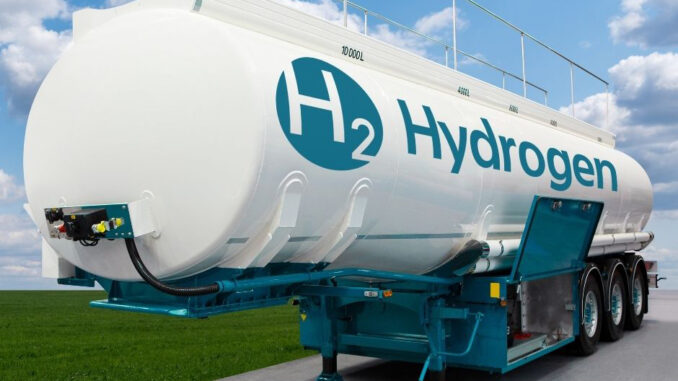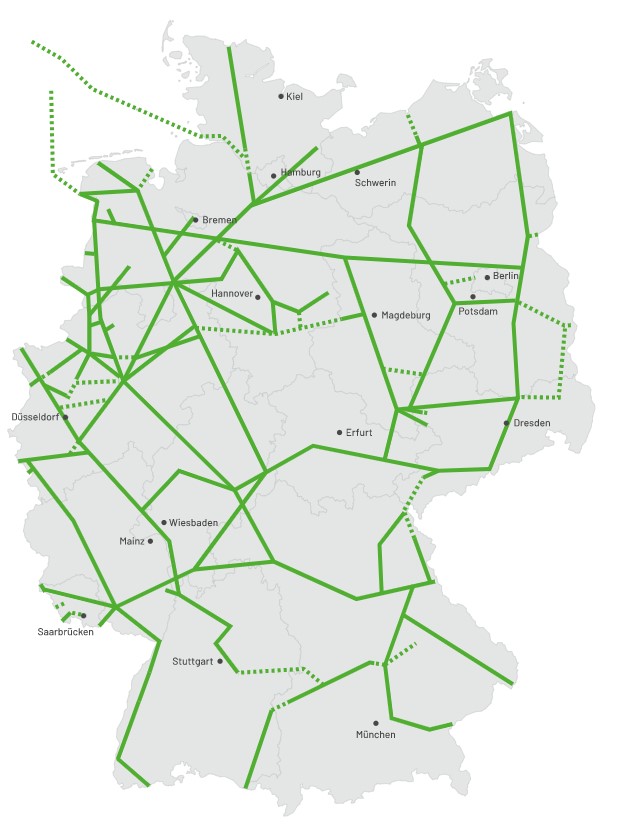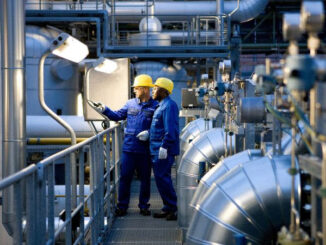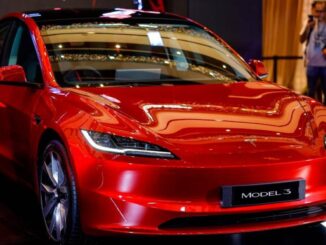
Germany needs a hydrogen infrastructure because an efficient, safe, affordable and climate-neutral energy supply will only be possible with the use of hydrogen. An efficient supra-regional hydrogen transport infrastructure is indispensable, especially for the integration of volatile renewable energy sources and a supply that meets demand at all times.
With the hydrogen network for a climate-neutral Germany (H2 network 2050), the transmission system operators (TSOs) are demonstrating that they can construct such a network efficiently and reliably at moderate investment costs. The H2 network 2050 has been further developed by the FNB from the “Visionary Hydrogen Network“ published in January 2020. This first picture of the future included many considerations, but without a network simulation for future hydrogen transport needs. The H2 grid 2050 now presented, on the other hand, is based on detailed grid planning.
Leitungsumstellung und -neubau

Fundamentals of the H2 network 2050
TSOs began scenario considerations and planning for the future hydrogen transport network in the spring of 2020. The basis is a scenario for the production and use of hydrogen in Germany developed together with the consulting firm 4Management based on the recognised dena Leitstudie I (TM95).[1]
The network planning takes into account the transport requirements of hydrogen for a climate-neutral target state in 2050. However, the hydrogen pipelines required for a climate-neutral energy system could also be realized as early as 2045 by adjusting the corresponding planning periods.
With the support of 4Management, the FNB have further developed the TM95 scenario. Against the background of the German hydrogen strategy and an emerging market demand, a more dynamic development of the hydrogen market was assumed. In particular, a stronger use of hydrogen in the industrial segment (especially steel and chemicals), a slightly increased use of hydrogen in the transport sector and a moderate use of hydrogen in power plants – especially in cogeneration – and in the heating sector have been assumed. At the distribution grid level, hydrogen blending and, in the long term, the conversion of entire grid areas to a supply of pure hydrogen were assumed.
Parameters of the H2 network 2050
The H2 Network 2050 is about 13,300 km long, of which about 11,000 pipeline kilometers are based on converted gas pipelines. The scenario under consideration assumes that demand for “green” methane will continue to be comparable to that for hydrogen in the future. In a scenario with lower use of methane (such as in the recently published dena study “Aufbruch Klimaneutralität”), further potential for optimization could be leveraged through a higher share of converted pipelines.
The planned hydrogen transport network can provide an energy volume of 504 TWh (calorific value), with a peak demand of about 110 GWh/h of hydrogen. More recent study results, such as the follow-up study to dena’s Lead Study I (dena’s Lead Study on the Dawn of Climate Neutrality), confirm the magnitude of the assumed future H2 demand.
The cost estimate for the hydrogen infrastructure shows that an efficient hydrogen transport network can be implemented at comparatively low cost. According to this, the investment costs up to the year 2050 will amount to around 18 billion euros. The estimate covers the cost of the necessary investments for interregional transport. Not included are, for example, costs for the conversion of storage infrastructure, for offshore lines or also lines for the connection of individual generation plants and to individual consumers. The development of the hydrogen infrastructure is complementary to the expansion of the electricity infrastructure, which is also necessary. According to the NEP Electricity, the investment requirement for this infrastructure alone is estimated at 72 – 76.5 billion euros by 2035. [2] 76.5 billion by 2035 alone. Integrated network planning can help optimize the overall network expansion required. The hydrogen infrastructure would enable and significantly accelerate the integration and storage of renewable energy via near-generation electrolysis plants. In addition, hydrogen pipelines provide many times more transport capacity than HVDC lines and can thus efficiently realize a large part of the energy imports to Germany that will also be needed in the future.
Details of the H2 network planning
The H2 Network 2050 is based on a fluid mechanics grid simulation. For this purpose, the TSOs defined specific entry and exit capacities at all entry and exit points of the future network and carried out a regionalization of the capacities for the industrial sector based on the existing industrial locations and the available current production volumes. Consumption in the transport and heating sectors was roughly regionalized on the basis of the existing network of filling stations and vehicle registrations, and in the heating market mainly on the basis of population figures.
In the simulations, future hydrogen demand is primarily covered by imports. The capacities at the country borders were based on the assessment of the hydrogen production potential of the different production regions. Based on the assumptions of the dena Leitstudie I TM95 scenario, approximately 63 GW of electrolysis capacity was planned in Germany in 2050, primarily located in northern Germany.
For the design of the grid, the TSOs considered different load scenarios depending on the availability of renewable energy and the existing cavern storage facilities.
Outlook
In addition to the work in the current Gas Network Development Plan 2022-2032, in which the TSOs are modeling the hydrogen transport network for the year 2032 in a demand-oriented manner based on a concrete market query (WEB – hydrogen production and demand), they will further develop the respective scenario-based modeling of the hydrogen transport network for the target year 2045 or beyond, taking into account new findings and studies.
At the same time, FNB’s detailed scenario-based analysis based on network simulations provides an important basis for setting the political course now for an efficient supraregional hydrogen transport infrastructure and for realizing the early opportunities for decarbonization through the use of hydrogen.
[1] FNB Gas (2021): Scenario framework for the NEP Gas 2022-2032, p.39
[2] Grid Development Plan for Electricity 2035, p. 176



